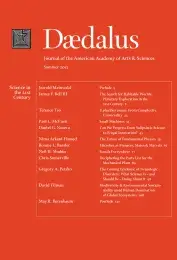Biodiversity & Environmental Sustainability amid Human Domination of Global Ecosystems
Concern about the loss of Earth’s biological diversity sparked two decades of research of unprecedented intensity, intellectual excitement, and societal relevance. This research shows that biodiversity is among the most important factors determining how ecosystems function. In particular, the loss of biodiversity decreases the productivity, stability, and efficiency of terrestrial, freshwater, and marine ecosystems. These research findings come at a time of rapidly increasing threats to global biodiversity resulting from agricultural land clearing, climate change, and pollution caused by globally accelerating demand for food and energy. The world faces the grand, multifaceted challenge of meeting global demand for food and energy while preserving Earth’s biodiversity and the long-term sustainability of both global societies and the ecosystems upon which all life depends. The solutions to this challenge will require major advances in, and syntheses among, the environmental and social sciences.
The existence of life is the defining feature of Earth, and diversity is the most striking aspect of life on Earth. Since the origins of life three billion years ago, the biological diversity of life, or its biodiversity, has been on an upward but jagged trajectory along which the formation of new species has exceeded, with but few exceptions, the loss of existing species. The exceptions were major extinction events, attributable to catastrophic occurrences such as meteor impacts and globally massive volcanic activity. Earth now has on the order of five million species, all descended from the same ancestor. This biodiversity has been an enduring source of wonderment and scientific mystery from the era of great naturalist-explorers, such as Darwin and Wallace, to the present.
Earth also has seven billion people who, in meeting their needs for food and energy, have become a globally dominant force affecting Earth’s ecosystems and threatening their biological diversity. The rapid acceleration in human global impacts through land-clearing and the destruction of natural habitats, fossil fuel combustion and climate change, nutrient pollution, and other activities has led to projections that humanity may be in the process of causing species extinctions at a rate rivaling some of the largest extinction events found in the fossil record.1 These projections have raised a series of questions and concerns, the most fundamental of which are: What caused the evolution of Earth’s amazingly great biodiversity? Does the loss of this biodiversity matter? Are there practices that could consistently and stably sustain the habitability of Earth while meeting the food, energy, and other needs and demands of the nine to ten billion people who will populate the planet by mid-century? If such practices are discovered, what policies, ethics, or approaches could lead to their global adoption?
. . .
